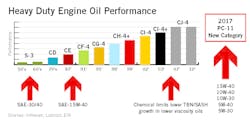Clean diesel engines are entering the era of enhanced fuel efficiency with PC-11
The adage that the air coming out of today’s diesel engine is cleaner than the air going into it is an exaggeration, but if nothing else, it serves up an image of just how clean today’s diesel engines have become. Even though diesel trucks are now running cleaner than ever, they are still considered inefficient, consuming relatively the same level of fuel as they did 40 years ago.
As a result of this low fuel economy and the subsequent greenhouse gases that come with it, the U.S. Environmental Protection Agency (EPA) and the National Highway Traffic Safety Administration (NHTSA) introduced new diesel fuel economy legislation in 2010. These new regulations will impact three classes of diesel-powered vehicles:
1. Heavy duty pickups and vans.
2. Vocational vehicles, such as buses, delivery vehicles and refuse trucks.
3. Combination tractor trailers.
Engine Efficiency
One aspect of the diesel fuel economy legislation involves engine efficiency. In response, the Truck and Engine Manufacturers Association (EMA) made a request to the American Petroleum Institute (API) to create a new diesel or commercial engine oil performance category. This new category, now in development, is temporarily called Proposed Category 11, or PC-11, and will eventually replace the current API diesel engine oil category CJ-4. See Figure 1.
The EMA represents worldwide manufacturers of internal combustion engines and on-highway medium and heavy duty trucks. API represents all segments of America’s oil and natural gas industry.
The legislation started its rollout in 2014, and the aspects that affect diesel engines will start being implemented in 2017. By 2020, fuel efficiency targets will range between 10 and 20 percent for the three vehicle classes. See Figure 2.
A Split Category
Born out of a necessity to maintain engine durability, diesel engine oil development has kept pace with engine designs intended to meet emission regulations.
In order to improve fuel economy, engine manufacturers are currently reporting that they are evaluating more than 800 variables that can impact fuel economy. Some of these engine design changes may place greater stress on engine oils, making it critical to achieve a balance between optimizing fuel economy and ensuring engine protection.
The development of PC-11 mirrors these two drivers and, because of this, breaks PC-11 down into two subcategories, A and B.
PC-11 A, or what will become API CK-4, will be focused primarily on performance updates to the long-standing API CJ-4. It will cover all current multigrade heavy duty engine oil viscosities including, 15W-40, 10W-30, 5W-40 and 5W-30.
PC-11 B, or what will become API FA-4, will focus primarily on optimizing fuel economy by lowering the limits of an engine oil property called High Temperature High Shear (HTHS) viscosity. This subcategory, with its lower HTHS levels, will apply only to the low-viscosity grades 10W-30 and 5W-30.
To put it more simply, API FA-4 low-viscosity oils will offer even better fuel economy for future engines, but may not offer backward compatibility to previous engine model years. Low-viscosity API CK-4 engine oils, which may not offer the same fuel economy as API FA-4, are believed to be backward compatible for previous model years.
What Happens Next?
With more than 80 percent of the diesel engine fleets in America still using 15W-40 conventional diesel engine oil, there is tremendous opportunity to achieve reduction in greenhouse gases and improved fuel efficiency by switching to 10W-30. Proof of this has already been seen with Citgo customers.
Fleets that switched from 15W-40 engine oil to Citgo Citgard 700 Synthetic Blend 10W-30 engine oil logged more than a million miles with an average 2.5 percent increase in fuel efficiency, resulting in better economics and better protection for engines.
However, the split-categorization of PC-11 raises questions about the speed in which we will all reach those fuel efficiency goals. Will fleet customers choose the PC-11 A oil in order to simplify inventory and cover engines of every age, thereby gaining some fuel efficiency, or will they split inventory to include the PC-11 B oil and get the most fuel efficiency out of their new engines, pushing the total fuel efficiency challenge to be resolved more quickly?
One thing is certain, whether the timeline is short or long, the change is inevitable.
Finding that balance between fuel economy and durability is a challenge for consumers and manufacturers alike, but having seen the transition from a single-grade diesel engine oil to the current multigrade era, I’m confident that it can be done.
Mark Betner is heavy duty lubricants manager for Citgo Lubricants (www.citgolubes.com), which manufactures a wide range of oils, fluids and greases for use in on-road and off-road fleets, equipment and vehicles, and offers customized lubricant solutions that improve productivity and efficiency. He has more than 35 years of experience in the lubricants business.
